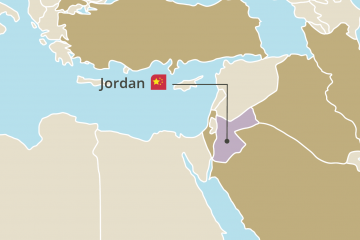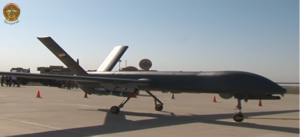
Jordan
For many years a country at the centre of a difficult military and political balancing act between its Arab neighbours, Israel, non-state actors such as Hamas and Hizbullah, and strong relationships with Western countries, in particular the UK, Jordan has long maintained modestly sized but highly professional and well-equipped armed forces. With the threat of Daesh (also known as the Islamic State of Iraq and Syria, ISIS) in neighbouring Iraq since 2014, Jordan has been exploring options for purchasing armed UAVs from the US for some years, without success. The US rejected a request from Jordan for unarmed Predator XP drones, despite selling them to the UAE.[1]
Likely as a result of this rejection, Jordan is rumoured to have acquired two Chinese CH-4Bs from China, manufactured by China Aerospace Science and Technology Corporation (CASC), sometime around 2016 – following a pattern common to several states in the region.[2] In their standard form, CH-4Bs are capable of delivering guided AKD-10 series Chinese air-to-ground missiles. The AKD-10 is of a similar size and class to the US AGM-114 Hellfire, used as the primary weapon for the US MQ-1 Predator and MQ-9 Reaper. It is uncertain whether the CH-4Bs have yet been cleared for operational service in Jordan. In November 2018, the Assistant Commander of the Royal Jordanian Air Force stated in an interview that the Royal Jordanian Air Force (RJAF) is not happy with the CH-4B and may retire them, without elaborating on why.[3] There has been no further confirmation or denial on this since.
NOTES
[1] Kate Brannen, ‘U.S. Firm Denied Request to Market Drones to Jordan’, Foreign Policy, 5 February 2015.
[2] See, for example, Jeremy Page and Paul Sonne, ‘Unable to Buy U.S. Military Drones, Allies Place Orders with China’, Wall Street Journal, 17 July 2017.
[3] See Alan Warnes, ‘The Assistant AF Commander of the Royal Jordanian Air Force isn’t very happy with his Chinese CH-4B armed UAVs. The RJAF looks set to retire them. He wouldn’t elaborate on the issues’ [Twitter post], 6:25am, 13 November 2018, <https://twitter.com/warnesyworld/status/1062350646588948480>, accessed 5 December 2018.
Armed UAV inventory

Drone
CH-4B Rainbow
Type
Medium Altitude, Long Endurance (MALE) UAV
Manufacturer
China Aerospace Science and Technology Corporation (CASC)
Number
2
Endurance
Up to 40 hours depending on payload
Loaded Weight
4500kg
Payload Capacity
345kg
Range
>1000km with SatCom, ~150km from Ground Control Station (GCS) if not.
Sensor Options
Infra-Red (IR) and Electro-Optical (EO) cameras, and laser designator in sensor ball.
Weaponry
‘A’ Variant is Unarmed. ‘B’ carries up to 345kg of payload on 4-6 wing hardpoints including: the AKD-10 air-to-surface anti-tank missile, BRMI-90 90mm guided rocket, FT-7/130 130kg glide bombs, FT-9/50 50kg bomb, FT-10/25 25kg bomb, GB-7/50 50kg precision-guided munition (PGM), and GB-4/100 PGM.
Given the lack of a robust threat and the existence of adequate military capabilities without the introduction of armed drones into service, the acquisition of CH-4Bs has not affected the way in which Jordan perceives the utility of airpower.
For a small, highly specialised force that must spend most of its resources on combat operations and state-on-state deterrence capabilities, the CH-4Bs are likely to be more of a demonstration of armed UAV country status rather than a core front line asset.
Chinese CH-4Bs are not interoperable with Western C2 systems, and the RJAF is heavily designed around being able to take part in US-led coalition operations with its F-16 and F-5 fast jets. Its personnel make much use of training arrangements with France, the UK and the US, and most of its electronic systems conform to Western standards. Although the CH-4Bs’ claimed endurance of up to 40 hours would undoubtedly be useful for surveillance against hostile activity on Jordan’s borders by non-state actors, the fact that the data they collect cannot be easily fed into the RJAF’s C2 systems limits them to a niche role. Much like the UAE, the primary goal of acquiring Chinese-armed UAVs may be to convince the US to sell Jordan the MQ-9 Reaper or MQ-1 Predator, which are more capable and would be much easier to integrate into the RJAF’s mission-planning, intelligence, surveillance and reconnaissance (ISR), and C2 architectures.[1]
The threat from Daesh is also much reduced, especially in Iraq, making the immediate operational imperative to induct the CH-4B into front line operations for border policing and security less pressing.
Given that military capabilities in Jordan are tightly controlled within the armed forces under the monarchy, it is unlikely that armed UAVs would in any case be employed outside the normal air force C2 structures and hierarchies, making it extremely unlikely that, even if and once they came into service, armed UAVs would lead to new operational norms and behaviour.
NOTE
[1] Confirmed by multiple author telephone interviews with experts in Middle Eastern geopolitics, July/August 2018.